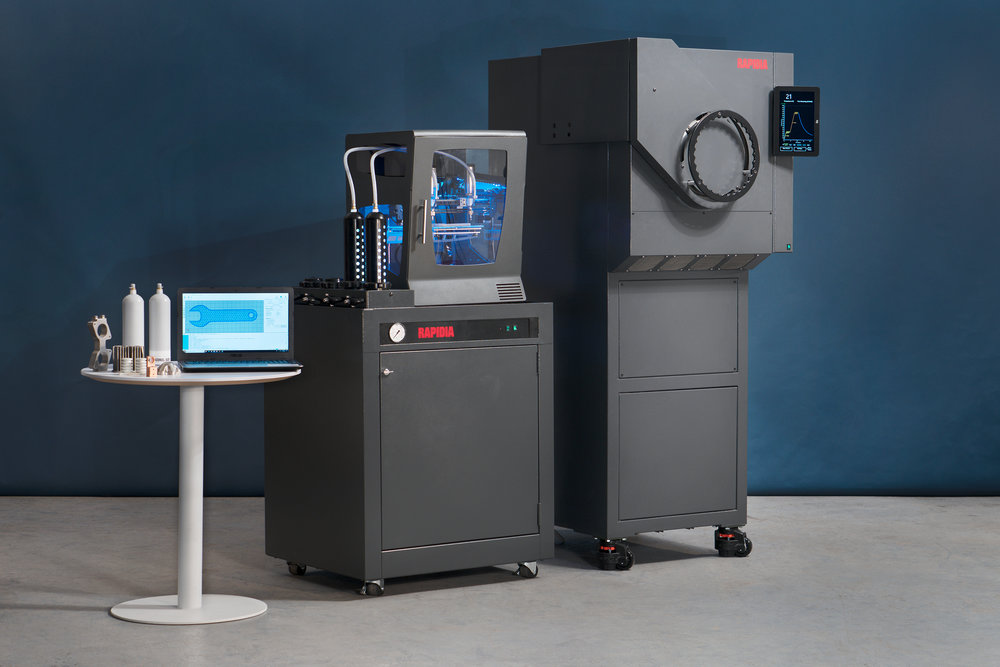Recently 3D Printing Industry was invited to visit the Vancouver HQ of 3D printer OEMRapidia. In this visit, we were given a preview of the company’s new two-step metal and ceramic 3D printer. Using an FDM/FFF-based technology, that does not require any debinding, the Rapidia 3D printer is taking on fierce competition within the metal additive market.
DanGelbart, an electrical engineer, is the founder and president of Rapidia. Gelbart holds several prestigious awards and honorary doctorates fromSimon Fraser Universityand theUniversity of British Columbia. He is also a co-founder ofKardium, a medical device manufacturer based in Burnaby, Canada.
Speaking with Gelbart and his team at Rapidia, I learned about the unique capabilities of the new system. Developed over the past three years, Gelbart says the Rapidia 3D printer “is the only system in the world that does not use loose powder and requires no debinding.”
“It is the only [FDM-based] system in the world which is a two-step system instead of three, everybody else has print, debind, sinter. And this is print and straight to sinter.”

Office compatible metal 3D printing
The Rapidia 3D printer works like a dual extruder FDM/FFF 3D printer. Therefore, in terms of geometry, whatever is possible with a standard FDM printer can be achieved with Rapidia. To form an object, the Rapidia 3D printer builds directly on a mildly heated glass bed without the need for a base or a raft. Its feedstock is a water-based metal paste or ceramic clay.
“We are the only system using water-based bound metal” explains Gelbart. Notable competitors of such a method, as highlighted by Gelbart, areDesktop MetalandMarkforged, the difference being that their systems “use metal powder bound by polymers,” meaning debinding is needed. “The advantage of bound metal,” Gelbart adds, “is that you can make an office compatible system.”
Working with a water-based paste for feedstock the printed object has several additional advantages: objectcan also be smoothed using a wet brush, allowing the use of coarser nozzles for faster printing. Water-based paste also enables a unique way of combining various parts to create a complex object. For example, a hollow object can be printed in three parts, base, midsection, and roof. Once printed these parts can be moistened and stacked on top of each other. After sintering in the furnace, the three parts fuse together to form a completely solid metal part. It is also possible to make a single object by combining freshly 3D printed and pre-machined objects.
In the furnace, the water content of the green part simply evaporates away. Though this creates concerns about the porosity of metal parts, according to Gelbart “after sintering, the object is solid metal, very little porosity [is] left. The green or brown objects are always porous, in all of the current processes. Porosity disappears in sintering. This is why the objects shrink in sintering.”
Rapidia 3D printer technical specifications
The Rapidia 3D printer can build parts as large as 200mm x 280mm x 200mm. It uses two independent extrusion heads which can be equipped with either a 0.4 mm or 0.6 mm diameter nozzle. The metal or ceramic paste is ejected out of the nozzles with the help of a high-pressure system enclosed in the bottom casing of the unit.
Two separate extruders allow printing of polymer-based supports which is beneficial for printing hollow bodies because the plastic support burns off during sintering.
In addition to the 3D printer, Rapidia has also manufactured a compatible furnace with a sintering volume of 235mm (inner diameter) by 400mm (depth). The furnace iscontrolled by a 10-inch touch screen. It has pre-installed software and sintering settings, therefore, requiring little to no technical knowledge from the operator. Another interesting feature of both the furnace and the printer is that they can be plugged into a regular 220-240 AC plug – so no special installation is needed to start the system. For North American installations, the printer plugs into a regular 120V wall outlet and the furnace plugs into a 240V 50A outlet, same as used for electronic appliances in home kitchens.
This is another aspect that makes Rapidia’s metal system safe for office and university environments.

See the Rapidia 3D printer firsthand
The Rapidia 3D printer is priced at $50,000 and the furnace costs $80,000. However, the printer and the furnace are independent units, and businesses who already own a furnace can buy only the Rapidia 3D printer.
From 21-23 May, Rapidia will present its new system at North America’s largest additive manufacturing eventRAPID + TCT 2019in Detroit, at booth 533.
When asked what he thinks will impress people most about the Rapidia metal 3D printer at the show, Gelbart emphasized, “The ability to fuse together different parts including machined parts and 3D printed parts is a huge benefit.”
“It will save a lot of money if you 3D print some of the pieces and stick them to machined parts. This is unique to this process. Also the ability to create complex internal structures by using evaporating supports is unique. Hand removable metal supports can not be removed from the inside of cavities.”

Vote now in the category of the best 3D metal printer for2019 3D Printing Awards.
To learn more about metal additive manufacturing subscribe to our3D printing newsletterand join us onTwitterandFacebook.
We also have jobs in the industry, visit our3D Printing Jobssite to find out more.
Featured image shows the Rapidia metal 3D system. Image via Rapidia.


